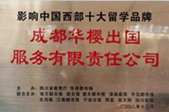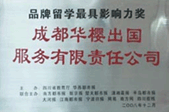· 影响中国西部十大留学品牌
· 西南唯一“英国教育咨询证书”
- 留学移民:400-012-1992
- 留学: 400-012-1992
- 树德国际部: 028-86119698/86119628
- 华樱外语: 400-012-1992
- 贵阳分公司: 0851-86502777
- 手机网站:m.cdhuaying.com

About Chengdu
Chengdu (Chinese: 成都), known formerly as Chengtu, is the capital of Sichuan province, of Southwest China, maintaining sub-provincial administrative status. Chengdu is also one of the most important economic centres, transportation and communication hubs in Western China. According to the 2007 Public Appraisal for Best Chinese Cities for Investment, Chengdu was chosen as one of the top ten cities to invest in out of a total of 280 urban centers in China.
More than four thousand years ago, the prehistorical Bronze Age culture of Jinsha (Chinese: 金沙; pinyin: Jīnshā) established itself in this region. The fertile Chengdu Plain, on which Chengdu is located, is called Tianfuzhi guo (simplified Chinese: 天府之国; pinyin: Tiānfǔzhi Guó) in Chinese, which literally means "the country of heaven", or more often seen translated as "the Land of Abundance". It was recently named China's 4th-most livable city by China Daily.
City nicknames
The name "Chengdu" has never changed since the city was founded, and the city has always been in the same location. The nicknames below are not formal names.
The Brocade City: Jinchéng, 锦城
In the Western Han Dynasty (206 BC-23 AD), brocade produced in Chengdu enjoyed great popularity among the royal and elite class in China. An emperor created the office of Jin Guan (锦官) to oversee brocade production in Chengdu. Since then, Chengdu has been called "Jin Guan Cheng" (锦官城) meaning Brocade Official's City, or in its short form, "Jin Cheng" (锦城) meaning Brocade city.
The City of Hibiscus: Róngchéng, 蓉城
In the Five Dynasties and Ten Kingdoms Period (907-960), Mengchang, the king of the Later Shu Kingdom, ordered the planting of hibiscus on the fortress wall surrounding the city. After this, Chengdu started being called the City of Hibiscus. Nowadays, the hibiscus is still the city flower of Chengdu, but the last city wall was torn down in the 1960s, along with the Royal Palace situated in the middle of the city, where the statue of Mao Zedong now stands.
Education
Colleges and universities
Chengdu is the center of higher education and scientific research in Southwest China.
National universities include:
- Sichuan University (SCU) (四川大学) (Founded in 1896)
- Southwest Jiaotong University (西南交通大学) (Founded in 1896)
- University of Electronic Science and Technology of China (电子科技大学) (Founded in 1956)
- Southwestern University of Finance and Economics (西南财经大学) (Founded in 1952)
Important provincial universities include:
- Sichuan Normal University (四川师范大学) (Founded in 1946)
- Southwest University for Nationalities (西南民族大学) (Founded in 1951)
- Chengdu Institute Sichuan International Studies University (四川外语学院成都学院) (Founded in 2000)
- Chengdu University of Technology (成都理工大学) (Founded in 1956)
- Southwest Petroleum University (西南石油大学) (Founded in 1958)
- Chengdu University of Traditional Chinese Medicine (CDUTCM) (成都中医药大学) (Founded in 1956)
- Sichuan Conservatory of Music(四川音乐学院) (Founded in 1939)
- Chengdu University of Information Technology (CUIT) (成都信息工程学院) (Founded in 1951)
- Chengdu Kinesiology University (成都体育学院) (Founded in 1942)
- Xihua University (西华大学) (Founded in 1960)
- Chengdu University (成都大学) (Founded in 1978)
- Chengdu Medical College (成都医学院) (Founded in 2004)
- Chengdu College of UESTC (电子科技大学成都学院)
- Sichuan Agricultural University (四川农业大学)
Note: Institutions without full-time bachelor programs are not listed.
International schools
- Chengdu Meishi International School
- Chengdu International School
- The Leman International School - Chengdu
- Quality Schools International
- QSI International School of Chengdu
- Eton House
Secondary schools
- Chengdu No.7 High School (成都七中)
- Chengdu Liewu High School (成都列五中学)
- Chengdu Shude High School (成都树德中学)
- Shishi Middle School (成都石室中学)
- The Affiliated High School of Sichuan University (四川大学附属中学)
- Shi Da Fu Zhong (四川师大附中)
- Chengdu Experimental Foreign Languages School(成都实验外国语学校)
- Chengdu Foreign Languages School (成都外语学校)
- Chengdu Shude Experimental School (成都树德实验中学)
- Chengdu Shude Union School (成都树德联校)
- Chengdu Shishi Union School (成都石室联中)
- Chengdu Yulin Middle School (成都玉林中学)
- Chengdu Guangya International School
Transportation
Intercity High-Speed Rail
The Chengdu-Dujiangyan High Speed Railway (成灌高速铁路) is a dual-track, electrified, passenger-dedicated, high-speed rail line in Sichuan Province, China. It connects the provincial capital, Chengdu with the satellite city of Dujiangyan in Guan County. The line is 65 kilometres (40 mi) in length with 15 stations. China Railways CRH1 train sets on the line reach a maximum speed of 220 kilometres per hour (140 mph) and make the full-trip in 30 minutes. The line was built in 18 months and entered into operation on May 12, 2010. The railway is built to withstand an 8.0-magnitude earthquake.
On May 28, 2008, 16 days after the Wenchuan Earthquake devastated Dujiangyan and the western suburbs of Chengdu, the Chengdu city government and the Ministry of Railways agreed to build a high-speed railway line as part of the reconstruction of the disaster zone. Construction began on November 4, 2008 and involved 20,000 workers at the cost of Y13 billion. The line entered trial operation on April 1, 2010 and full commercial operation began on May 12, 2010, the second anniversary of the large earthquake that killed some 70,000 people in the region.
The route uses CRH1 trains in eight-car train sets, which can carry 661 passengers. Each day, 15 pairs of trains are scheduled daily between Chengdu and Dujiangyan’s Mountain Qingcheng Station.
Chengdu metro
Chengdu Metro officially opened on 1 October 2010. The 18 km North-South Line runs from Shenxian Lake (near northern railway station) to Century City (south Chengdu/Software Park). Four more lines are planned to open in the (near) future.
Expressways
Chengdu's transportation network is well developed, and Chengdu serves as the starting point for many national highways, with major routes going from Sichuan-Shanxi, Sichuan-Tibet, and Sichuan-Yunnan.
For the year 2007, Chengdu announced the official launch of 37 significant projects, including the Chengdu-Jianyang Expressway in an attempt to accelerate the construction of the experimental district. This project is expected to solve the current transportation problem, which is proved to be the bottleneck in Jianyang's development. Development of major tunnels and the Longquan Lake scenic spot has also been planned to integrate Jianyang better into the Chengdu economic circle.
Several major road projects were also mentioned in the paper: a 15 km tunnel from Shuangliu Taiping to Jianyang Sancha Lake; alteration of the National Expressway 321, from Jiangyang to Longquanyi, totaling 26 kilometers. There will also be a road that connects Longquan Town to Longquan Lake - it will be connected to the Chengdu-Jianyang Expressway and hence shorten the journey by 10 kilometers. The authority has yet to decide whether drivers will have to pay tolls to access the road.By the end of 2008, there are ten expressways, connecting the center of Chengdu to its suburbs. The expressways that will be open to the public by the end of December are the Chenglin Expressway, extensions of Guanghua Avenue, Shawan Line, and an expressway from Chengdu to Heilongtan.
- The toll-free Chengjin Expressway in the east of Chengdu is 38.7 km long, with six lines and designed for travel at 80 km/h. After it opens to the public, it will take only about half an hour to drive from the downtown Chengdu to Jintang, half the time of the current journey.
- The expressway between Chengdu to Heilongtan (Chengdu section), going to the south of the city, is 42 km long. It is also toll-free and a journey from downtown Chengdu to Heilongtan will only take half an hour.
- The extension of Guanghua Avenue, going towards the west of the city, is 11.6 km long with an estimated investment of 300 million yuan. It will cut the journey time from Chongzhou city to Sanhuan Road to less than half an hour.
- The extension of Shawan Road going north will be 8.8 km long, and is designed for travel at 60 km/h. After it is connected to the expressways Pixian–Dujiangyan and Pixian–Pengzhou, it will take only 30 minutes to go from Chengdu to Pengzhou.
- Via the Sichuan-Tibet Highway, from Chengdu to Nagchu (near Lhasa) is a distance of 2028 km.










